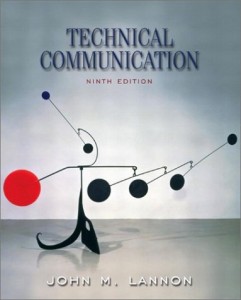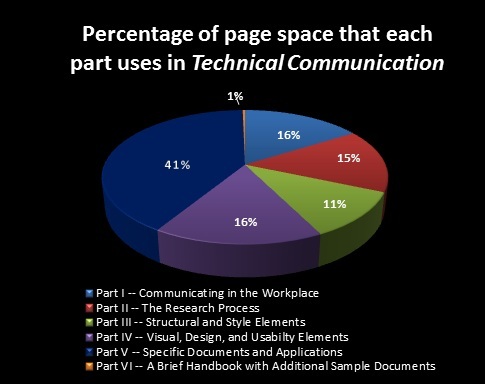Textbook Analysis: John M. Lannon’s Technical Communication (9th Ed.)
The cover of Technical Communication (9th Ed.) by John M. Lannon
Introduction
The ninth edition of John M. Lannon’s Technical Communication particularly focuses on the social aspects of technical communication, and emphasizes the importance of audience awareness, ethical considerations, and understanding the contexts of workplaces. The textbook’s preface lists several changes from the eighth edition, including:
- Updated chapters on Web design, document design, and usability that “reflect changes in the technology”
- Added exercises focused on service-learning
- Expanded chapter on collaboration
- Increased coverage of information literacy and critical thinking throughout Part II
- More comprehensive look at ethical and legal issues, and an increased attention to international and global workplace issues (p. xix-xx).
The textbook is divided into six different parts:
- Communicating in the Workplace
- The Research Process
- Structural and Style Elements
- Visual, Design, and Usability Elements
- Specific Documents and Applications
- A Brief Handbook with Additional Sample Documents (p. v-vi).
The percentage of page space that each part uses in Lannon’s Technical Communication. Part IV, “Visual, Design, and Usability Elements,” was the longest section of the textbook.
Writing process
Writing is very much defined as a process in Technical Communication. Lannon breaks down writing into five stages: “gather[ing] and evaluat[ing] ideas and information, plan[ning] the document, draft[ing] the document, and revis[ing] the document” (p. 18). Lannon writes that, “Each of these stages are enriched by creative and critical thinking,” and insists that these stages aren’t completely linear: “No one stage of the writing process is complete until all stages are complete” (p. 19). Thus writing, in Lannon’s view, is a recursive process.
Rhetoric and persuasion
Technical Communication places a great deal of emphasis on audience awareness and the power of persuasion. Chapters 3 and 4, in particular, focus on audience awareness and persuasion.
Chapter 3 lists several types of audiences that technical communicators may encounter, and how to address each audience type effectively. Chapter 3 also offers four pages on topics to consider when writing for a specific audience, including the:
- Purpose of the document
- Audience’s technical background
- Audience’s cultural background
- Audience’s knowledge of the subject
- Appropriate details, format, and design
- Due date and timing (p. 32-35)
Chapter 4, titled “Making a Persuasive Case,” focuses on defining persuasion, outlining the different persuasive goals people may have, and addressing how to write persuasively (p. 39-68).
Style and tone
The entirety of Part III is covers style and tone. Chapter 12, “Organizing for Users,” is concerned with structuring paragraphs and sequencing. Chapter 13, “Revising for Readable Style,” identifies several goals related to tone and style for the ideal document. According to this section, readable documents should be:
- Clear
- Concise
- Fluent
- Focused on using exact word choice
Readable documents should also use an active tone and avoid personal bias.
Lannon points out in Chapter 1 that: “Technical communication does not seek to entertain, create suspense, or invite differing interpretation . . . it leaves little room for ambiguity . . . Technical communication . . . doesn’t address your feelings, hopes, dreams, and feelings” (p. 3).
Document design
Chapters 15 through 17 cover document design. Chapter 15 specifically addresses page and document design, while Chapter 16 addresses document supplements, and Chapter 17 addresses designing and testing documents for usability. Chapter 15 treats document design as a process that occurs after “tailoring the material for the audience, building a persuasive case, organizing for users’ understanding, honing sentences and word choice, and using visuals. According to the chapter, it is only after these decisions have been made that document design occurs: “Finally, you decide how to present your communication on the page itself, to achieve a specific effect.” Page design is described as “determin[ing] the look of a page (whether hard copy or electronic), the arrangement of words and visuals” (p. 344, emphasis mine).
Document genres and types of writing
Although document genres and types of writing are not specifically addressed until Part V of the textbook, the topic is covered extensively. Seven of the nine chapters in Part V specifically address different document genres. These chapters cover:
- Memo reports and electronic mail
- Letters and employment correspondence
- Web pages and other electronic documents
- Instructional documents
- Proposals
- Analytical reports
- Oral presentations
Visuals and oral communication
Visual Design, Chapter 14: Brumberger (2007) posits that visual and verbal thinking should be treated as complementary (p. 389). Like Brumberger, Lannon makes the argument that verbal and visual messages should ideally work together to create meaning: “This doesn’t mean that verbal messages have become obsolete. Instead, words integrate with shapes and images to create what design expert Robert Horn calls visual language” (Lannon, 2003, p. 291).
Technical Communication addresses a wide variety of visual genres, including:
- Tables (numerical and prose tables)
- Graphs (bar and line graphs)
- Charts (pie charts, organization charts, flowcharts, Gantt charts, tree charts, and pictograms)
- Graphic Illustrations (representational, exploded, cutaway, and schematic diagrams, and maps and photographs)
Oral Communication, Chapter 26: This section opens with a section titled, “Avoiding Presentation Pitfalls,” and offers a table to describe things that may go wrong in a presentation, because of the speaker, poor visuals, or the presentation setting. After discussing how to avoid these negatives, the text goes on to describe how to plan a presentation effectively. The textbook approaches this topic through a focus on rhetorical context; the first three sub-sections are titled, “Work from an Explicit Purpose Statement,” “Analyze Your Listeners,” and “Analyze Your Speaking Situation” (p. 639-640).
Research and writing technologies
The textbook emphasizes research methods, devoting Part II (15% of its page space) to the topic. Research is described as “a deliberate form of inquiry, a process of problem solving in which certain procedures follow a recognizable sequence.”
Both the procedural and inquiry stages of the research project are depicted in flowchart form (p. 119).
The textbook does not stress writing technologies nearly as often as it stresses the research process; Chapter 20 is the only chapter to specifically address the topic.
Citations
Brumberger, E.R. (2007). Making the strange familiar: A pedagogical exploration of visual thinking. Journal of Business and Technical Communication. 21(4 ). Retrieved from http://courses.johnmjones.org/ENGL605/wp-content/uploads/2012/05/Brumberger-2007.pdf
Lannon, J.M. (Ed.). (2003). Technical communication (9th ed.). New York, NY: Longman.

